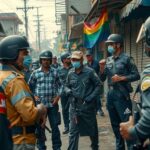Violence Erupts as Bangladeshi Garment Workers Protest Job Layoffs
On October 31, 2024, clashes erupted in Dhaka between garment workers and police, resulting in injuries to two teenagers during protests against job layoffs in an industry crucial to Bangladesh’s economy. The garment sector has faced extensive unrest due to factory closures, with significant financial losses reported since August 2024.
On October 31, 2024, garment workers in Dhaka, Bangladesh engaged in violent clashes with police and military personnel amidst their ongoing protests against mass layoffs in a crucial sector of the economy. The protests, primarily staged in the Mirpur area, escalated after the abrupt closure of a garment factory, leading to the injury of two teenagers, aged 15 and 17, who were shot during the confrontation. The incident reflects growing unrest in a sector that constitutes approximately 85 percent of Bangladesh’s $55 billion export economy, which is predominantly dependent on clothing manufacturing.
The garment industry is vital to Bangladesh, positioning the country as the second-largest clothing exporter globally, following China. It supplies many renowned international brands such as Levi’s, Zara, and H&M. As economic pressures mount, workers have increasingly taken to the streets to voice their discontent, resulting in violence and significant economic losses, which were estimated at $400 million since August 2024, according to the Bangladesh Garment Manufacturers and Exporters Association.
The garment workers’ protests stem from rising tensions caused by widespread job cuts, particularly following the closure of several factories in Dhaka. The unrest has been exacerbated by previous disruptions arising from a student-led revolution, which ousted ex-leader Sheikh Hasina in August. With an interim government led by Nobel Prize laureate Muhammad Yunus now in power, the labor force is experiencing a series of demonstrations demanding job security and fair wages. The situation signifies the critical state of the garment industry in Bangladesh, where labor rights and economic stability are perennially under scrutiny.
The recent clashes between garment workers and security forces in Dhaka underscore the escalating tensions within Bangladesh’s essential clothing sector. As protesters continue to demand better employment conditions, the violent events of October 31 reflect widespread dissatisfaction and the industry’s critical role in the national economy. The need for urgent dialogue and resolution is paramount to restore stability and safety for both workers and the economy.
Original Source: www.heraldmalaysia.com








Post Comment